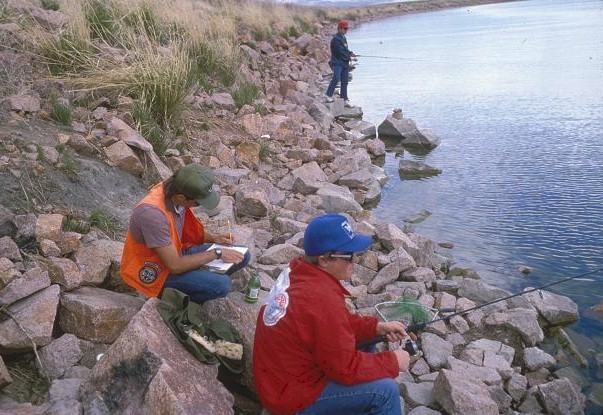Why does the CPW conduct fishery surveys?
 Colorado Parks and Wildlife (CPW) is the lead agency responsible for fisheries management of public waters in the State of Colorado. The primary tool that guides fish management is the lake and stream survey. These surveys primarily consist of periodic monitoring of fish populations. During the survey process fish are collected using a variety of gears and returned to the water after the necessary biological data is recorded. A variety of gear is used to gauge the entire fish community rather than a single species. See the survey methods section below for more information.
Colorado Parks and Wildlife (CPW) is the lead agency responsible for fisheries management of public waters in the State of Colorado. The primary tool that guides fish management is the lake and stream survey. These surveys primarily consist of periodic monitoring of fish populations. During the survey process fish are collected using a variety of gears and returned to the water after the necessary biological data is recorded. A variety of gear is used to gauge the entire fish community rather than a single species. See the survey methods section below for more information.
The collected data is used to track fish population trends, evaluate the effectiveness of management actions such as stocking and regulations, and establish realistic management goals for a given lake or stream.
The fisheries section of CPW conducts hundreds of lakes and streams surveys each year. High priority and brood waters such as Chatfield, Pueblo, Horsetooth, and the Gunnison River are surveyed annually. Smaller, more remote, or lightly used lakes or streams may only be surveyed once every 5-10 years. Most of the survey fieldwork takes place from early June through late September, however, many areas also conduct more specialized sampling beginning right after ice-out and again in the fall prior to freeze-up.
To better educate Colorado’s anglers, and provide the most up-to-date and unbiased information, CPW is pleased to share the survey information from some of Colorado’s most popular angling waters. Please note that publishing this information is a new endeavor by CPW’s aquatic biologists and some waters have yet to be posted.
Check out
Fishery Survey Summaries for a lake and stream list or read the
2019 Statewide Fisheries Assessments and Surveys.
Methods for Surveying Fish in Colorado’s Waters
Electrofishing uses electricity to stun fish before they are caught. Electrofishing is a common scientific survey method used to sample fish populations to determine abundance, density, and species composition. When performed correctly, electrofishing results in no permanent harm to fish, which return to their natural state seconds after being stunned. There are three primary types of electrofishers Colorado Parks and Wildlife typically uses: boat mounted models, backpack models, and shore mounted models. All models rely on one or two electrodes which deliver current into the water to stun fish. The current runs between the electrodes, creating a high-voltage potential. When a fish encounters a large enough potential gradient, it becomes affected by the electricity causing involuntary movement toward the positive electrode. This specialized type of equipment is most often used for sampling largemouth bass, smallmouth bass, all species of trout, young of the year walleye, and native minnows.
 When
boat electrofishing, the boat itself is the negative, and the positive electrodes are generally mounted off the bow. The stunned fish move toward the positive, where they are caught alive using a dip net. Boat electrofishing is routinely used to sample small ponds, large reservoirs, and large rivers such as the Yampa or Colorado.
When
boat electrofishing, the boat itself is the negative, and the positive electrodes are generally mounted off the bow. The stunned fish move toward the positive, where they are caught alive using a dip net. Boat electrofishing is routinely used to sample small ponds, large reservoirs, and large rivers such as the Yampa or Colorado.
 Backpack electrofisher units are either battery or gas powered. The positive is located at the end of a long pole and is usually in the form of a ring. The negative is a long braided steel cable that trails behind the operator. The electrofisher is operated by a switch on the pole. Backpack units are used to sample remote locations and small streams.
Backpack electrofisher units are either battery or gas powered. The positive is located at the end of a long pole and is usually in the form of a ring. The negative is a long braided steel cable that trails behind the operator. The electrofisher is operated by a switch on the pole. Backpack units are used to sample remote locations and small streams.
 Shore-mounted models operate in a similar fashion as the backpack unit; however the power source is stationary allowing crew members in the stream more mobility and a wider electrical field while sampling. Shore mounted models are used to sample medium to large rivers such as the Big Thompson and Taylor.
Shore-mounted models operate in a similar fashion as the backpack unit; however the power source is stationary allowing crew members in the stream more mobility and a wider electrical field while sampling. Shore mounted models are used to sample medium to large rivers such as the Big Thompson and Taylor.
 Trap nets are stationary nets that are set perpendicular to the shoreline. The shore-end of the net is staked and the nets is stretched and then anchored to the lake bottom. The standard trap net is 4 feet tall by 4 feet wide with a 40 foot lead. Trap nets are generally set in water less than 6 feet in depth. The stretched portion of the trap net forms a labyrinth-like chamber into which fish can easily enter, and from which they cannot easily escape. The number of trap net sets during a survey is dependent on the lake acreage. Trap nets effectively sample bluegill, brown trout, crappie, northern pike and yellow perch.
Trap nets are stationary nets that are set perpendicular to the shoreline. The shore-end of the net is staked and the nets is stretched and then anchored to the lake bottom. The standard trap net is 4 feet tall by 4 feet wide with a 40 foot lead. Trap nets are generally set in water less than 6 feet in depth. The stretched portion of the trap net forms a labyrinth-like chamber into which fish can easily enter, and from which they cannot easily escape. The number of trap net sets during a survey is dependent on the lake acreage. Trap nets effectively sample bluegill, brown trout, crappie, northern pike and yellow perch.
 Angler creel surveys are used to determine the species and number of fish captured in a specific stream, lake, or region over a specified time or season. These surveys rely on fishermen to provide information about the amount of time they have been fishing, what they are fishing for, what they have caught or released, where they are from, and particular fishing preferences. The information collected through angler surveys gives the CPW an unbiased sample of the angling population that is used in addition to the electrofishing and net assessments to select the best management plans to accommodate the widest variety of anglers.
Angler creel surveys are used to determine the species and number of fish captured in a specific stream, lake, or region over a specified time or season. These surveys rely on fishermen to provide information about the amount of time they have been fishing, what they are fishing for, what they have caught or released, where they are from, and particular fishing preferences. The information collected through angler surveys gives the CPW an unbiased sample of the angling population that is used in addition to the electrofishing and net assessments to select the best management plans to accommodate the widest variety of anglers.
 Gillnets are a passive fishing gear consisting of panels of net held vertically in the water column typically in contact with the lakebed, such that fish attempting to swim through the net are entangled. Fish are held behind the gill plate as the head passes through the net. The mesh size of the net determines the size range of fish caught. The standard gill net is 6 feet tall by 150 feet long, with 6 different mesh sizes to gauge all sizes of fish in particular water. Because fish inhabiting colder waters grow at slower rates (ex. Dillon Reservoir), gillnets deployed at higher altitudes have slightly smaller mesh compared with the mesh sizes used in warmer lakes (ex. Pueblo Reservoir). To minimize mortality, gillnets are typically set in the late evening and pulled early the following morning. Gillnets efficiently target adult walleye, wiper, lake trout, rainbow trout, suckers, common carp, and gizzard shad. The number of gillnet sets during a survey is dependent on the particular lake acreage.
Gillnets are a passive fishing gear consisting of panels of net held vertically in the water column typically in contact with the lakebed, such that fish attempting to swim through the net are entangled. Fish are held behind the gill plate as the head passes through the net. The mesh size of the net determines the size range of fish caught. The standard gill net is 6 feet tall by 150 feet long, with 6 different mesh sizes to gauge all sizes of fish in particular water. Because fish inhabiting colder waters grow at slower rates (ex. Dillon Reservoir), gillnets deployed at higher altitudes have slightly smaller mesh compared with the mesh sizes used in warmer lakes (ex. Pueblo Reservoir). To minimize mortality, gillnets are typically set in the late evening and pulled early the following morning. Gillnets efficiently target adult walleye, wiper, lake trout, rainbow trout, suckers, common carp, and gizzard shad. The number of gillnet sets during a survey is dependent on the particular lake acreage.

